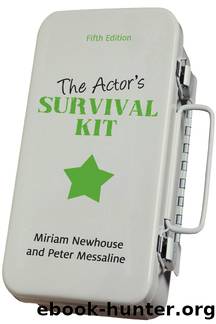The Actor's Survival Kit by Miriam Newhouse & Peter Messaline

Author:Miriam Newhouse & Peter Messaline
Language: eng
Format: epub
Publisher: Dundurn Press
Published: 2010-08-17T04:00:00+00:00
Eating
There will generally be coffee and doughnuts around somewhere all day, and meals every four or five hours. Try not to go overboard with food and drink. Most actors find it impossible to resist the lure of free food, and the food on film and television shoots is generally excellent. However, if after lunch you have a scene that needs energy, it would be as well to have the blood coursing through your veins rather than sitting in your gut, trying to digest the lasagna you have shovelled down.
On Set
The call comes at last and you head for the set, not forgetting your costume pieces and props and your own shoulder bag. In small projects, you may be able to discuss with the director, before you get onto the set, what the scene is about, any questions you may have, and any specific route he wants you to take through the role. Donât expect this in mainstream media work: some directors do make a point of at least touching base with even the lowliest day player, but itâs rare. Normally, you will be expected to work it out for yourself. According to director Gail Singer, âLots of new directors donât know how to direct actors. They donât understand the acting process. In their own training they tend to use fellow directing students as actors. Also, some directors havenât worked on the text sufficiently to articulate to the actor what is needed.â In studio work, the director may stay up in the control room and communicate through his floor manager (or first AD).
Down in the studio or out on the location set, you will be appalled by the chaos. Cables in all directions, lights on and lights off, lights humming and occasionally smoking, men and women looking confident and competent, with titles like gaffer, craft services, focus puller, clapper loader. Dire warning: donât touch the equipment. This is for your own protection. The equipment itself is rarely dangerous, but a glare from a union technician can kill at forty paces. Marc Green, sound recordist: âI canât stand it when someone blows into the mike! It puts pressure on the mike itâs not built for and it puts moisture in it, which causes static. And itâs a great way to destroy my ears.â
It is likely they called you as they were finishing the previous shot, so that when you arrive they will be setting up the camera and lights for yours. They may have called you early and are still shooting. Obviously you wonât walk into a studio when the ârecordingâ light is on, but you wonât get that warning on an outdoor set. Look for the cameras; catch an eye and ask where to wait. Wait there. Watch whatâs happening. Learn what you can â just a basic understanding some idea of what and why. The chaos will begin to have a shape, and you will see that the director has many threads to keep an eye on. You are only one.
Download
This site does not store any files on its server. We only index and link to content provided by other sites. Please contact the content providers to delete copyright contents if any and email us, we'll remove relevant links or contents immediately.
Call Me by Your Name by André Aciman(20371)
Ready Player One by Cline Ernest(14524)
How to Be a Bawse: A Guide to Conquering Life by Lilly Singh(7391)
Wiseguy by Nicholas Pileggi(5671)
The Kite Runner by Khaled Hosseini(5083)
On Writing A Memoir of the Craft by Stephen King(4863)
Audition by Ryu Murakami(4850)
The Crown by Robert Lacey(4723)
Call me by your name by Andre Aciman(4619)
Gerald's Game by Stephen King(4581)
Harry Potter and the Cursed Child: The Journey by Harry Potter Theatrical Productions(4440)
Dialogue by Robert McKee(4321)
The Perils of Being Moderately Famous by Soha Ali Khan(4169)
Dynamic Alignment Through Imagery by Eric Franklin(4116)
Apollo 8 by Jeffrey Kluger(3637)
Seriously... I'm Kidding by Ellen DeGeneres(3577)
The Inner Game of Tennis by W. Timothy Gallwey(3575)
How to be Champion: My Autobiography by Sarah Millican(3555)
Darker by E L James(3477)
